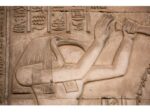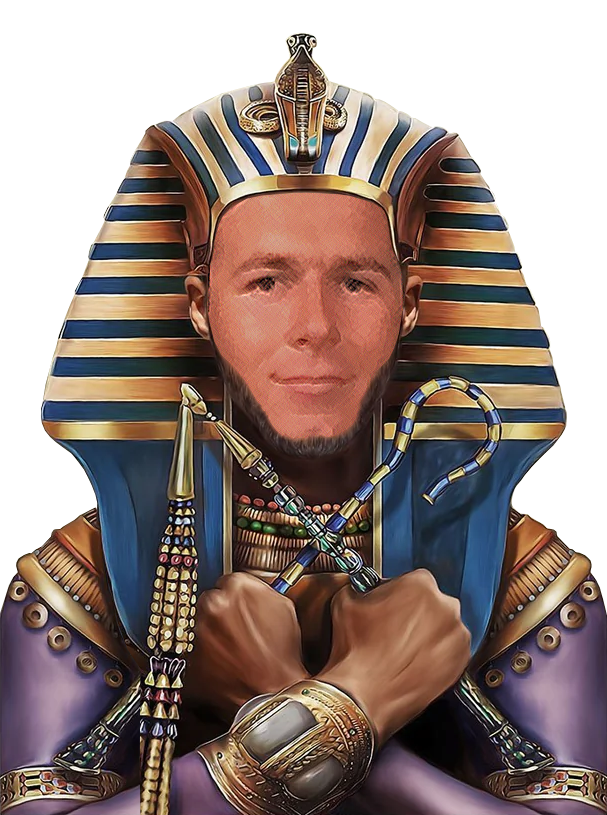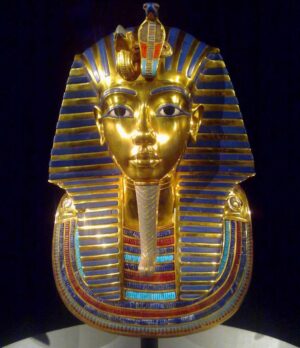In the spirit of L. Ron Hubbard’s written fantasies, I decided to use the moniker, Imhotep, as the host of PseudoScientology as a nom de plume or a literary double merely to add a creative edge to my efforts to research the church of Scientology. My earlier effort back in 2008 was a rather Spartan attempt at blogging and didn’t exactly float any needles on the E-Meter “Creative Scale.”
So here we … Imhotep was quite randomly chosen, but as we will discover, the choice is one that even the ancient God of Irony, Momus, would smile upon. And please note: I just borrowed King Tut’s golden funeral mask. He’s obviously not using it anymore and it looked really cool … and that silly curse is long past its “Best If Used By” date.
WHO WAS THE REAL IMHOTEP?
Imhotep was one smart dude. His IQ would certainly have qualified him for Mensa International. He’s even been referred to as a “Multi-Genius.”
Imhotep, which means “he who comes in peace.” Imhotep held many titles such as sage, scribe, poet, chief lector priest, architect, astronomer, magician, chief physician to the king, and second in command of Kemet (Egypt).
Imhotep received accolades for his literary mastery that earned him recognition in modern times as; “the first man of science in recorded history,” “the real Father of Medicine and healing,” and “the world’s first doctor.” Sir William Osier also commented that, “The first figure of a Physician to stand out clearly from the mists of antiquity.”

Archaeologist Zahi Hawass was appointed to oversee the restoration of the stone Step Pyramid near Saqarrah, built by architect Imhotep for King Djoser around 2780 B.C.E.
It is known that the Egyptian scholar Imhotep was born a commoner. Researchers tell us that it was his sheer talent, innate wisdom, and ambition that enabled him to rise from a lowly temple priest to the top of the ancient Egyptian social hierarchy. It allowed him to build the first pyramids in Egypt, practice medicine, and write a booklet that is sadly lost today. As a result of all these achievements, he was recognized as one of the greatest scientists of antiquity, and even non-Egyptians worshiped him as a god.
Successor to the King of Upper Egypt, Imhotep was Chancellor, Physician, Administrator of the Royal Palace, Hereditary Nobility, High Priest of Heliopolis, Master Builder, Chief Carpenter, Chief Sculptor, and Vase Maker. Imhotep lived in the 27th century BC.
Imhotep is most famous as the architect and builder of King Djoser’s unprecedented Step Pyramid complex called the Refreshment of the Gods. In this complex, Djoser became a god after death and participated in religious festivals along with other gods and goddesses from the ancient Egyptian pantheon. Imhotep placed the king’s actual final resting place more than 20 meters (65 feet) below him in the six-tiered pyramid. Even today, despite decades spent exploring the complex with different scientific methods and equipment, large areas to the north and west of the pyramid remain unexcavated and probably hide major secrets of Djoser and his famous architect. An incredible tour of the Djoser pyramid is here.
 The pedestal of the Djoser statue in the Egyptian Museum shows that Imhotep held an important position in Egyptian society. This base contains Imhotep’s most important and only known titles: “Prince, Royal Seal-Holder of the Kings of Lower Egypt, High Priest of Heliopolis, Chief Sculptor.” It is believed that he was considered a respected member of the royal family.
The pedestal of the Djoser statue in the Egyptian Museum shows that Imhotep held an important position in Egyptian society. This base contains Imhotep’s most important and only known titles: “Prince, Royal Seal-Holder of the Kings of Lower Egypt, High Priest of Heliopolis, Chief Sculptor.” It is believed that he was considered a respected member of the royal family.

Bronze figurine of Imhotep. The papyrus on his lap, reads “the Great One, son of the god Ptah”
A life-size limestone statue of King Djoser has been transformed and is now featured in a new exhibit at the Egyptian Museum in Cairo. This statue shows the king seated on a throne, wearing a three-part headdress and a long robe around his body. The statue bears traces of stucco, and the eyes may have been inlaid with precious materials.
During the reign of King Djoser, Egypt suffered a seven-year famine. The king asked Imhotep to find a solution. According to historians, Imhotep consulted ancient writings and instructed the Egyptians to pray to Khnum, who was said to have alleviated the famine. However, we also know that Imhotep built an irrigation system that could supply water to his fields even when the water level in the river was low. Prayer built people’s trust, but perhaps the irrigation system was the real solution.
The Famine Stela is a granite inscription telling us that for seven years during the reign of the ancient Egyptian king Djoser, the Nile failed to go through its annual flooding cycle, causing a devastating drought and famine. Looking for an end to his people’s suffering, the king consulted his architect and prime minister, Imhotep, commanding him to dig for a solution in the old sacred texts. A full accounting of the Stela engraving can be found at EgyptToday.com.
Imhotep Documentary: YouTube
xxxx
You will recall that I mentioned at the beginning  there was some irony in that “random” selection of the name Imhotep for my moniker. After turning to my Artificial Intelligence buddy, ChatGPT, that irony earned the adjective, “Exquisite.” As we work our way through the following interview, let’s think of Mr. Chat as the 21st Century “Hal 9000,” the famous (Heuristically programmed ALgorithmic computer) from Stanley Kubrick’s “2001: A Space Odyssey.” Only this time, we tone down the “sadistic antagonism” and turn up the “hyper-intelligence.” Although “Counsel for the Defense” may offer an occasional “Objection … leading the witness,” I think you’ll eventually see an interesting conclusion.
there was some irony in that “random” selection of the name Imhotep for my moniker. After turning to my Artificial Intelligence buddy, ChatGPT, that irony earned the adjective, “Exquisite.” As we work our way through the following interview, let’s think of Mr. Chat as the 21st Century “Hal 9000,” the famous (Heuristically programmed ALgorithmic computer) from Stanley Kubrick’s “2001: A Space Odyssey.” Only this time, we tone down the “sadistic antagonism” and turn up the “hyper-intelligence.” Although “Counsel for the Defense” may offer an occasional “Objection … leading the witness,” I think you’ll eventually see an interesting conclusion.
Question: Did the Egyptian high priest Imhotep ever mention the Eye of Horus or was he in the same time period in Egypt’s history?
The Eye of Horus does not appear to have been mentioned by Imhotep, who lived during the Third Dynasty of Egypt in the 27th century BCE. However, the Eye of Horus (or Wadjet, as it was known in ancient Egyptian culture) is believed to have originated sometime in the Early Dynastic Period (c. 3150–c. 2613 BCE), which predates Imhotep’s life.
Question: What is the BCE time period for Imhotep?
Imhotep lived during the Third Dynasty of Egypt in the 27th century BCE, which dates to approximately 2650–2600 BCE.
Question: Was the god Horus recognized by any of the Pharaohs of the Third Dynasty?
Yes, Horus was recognized by some of the Pharaohs of the Third Dynasty, including Djoser, Sekhemkhet, and Khaba.
Question: What other gods were recognized during Egypt’s Third Dynasty?
Other gods recognized during Egypt’s Third Dynasty included Ptah, Ra, Osiris, Isis, Thoth, Anubis, Hathor, and Nephthys.
Question: Which Pharoah did Imhotep serve under and what was his title and responsibilities?
Imhotep served under the Pharaoh Djoser of the Third Dynasty, and his title was “Chancellor of the King of Lower Egypt, Doctor, First in line after the King of Upper Egypt, Administrator of the Great Palace, Hereditary nobleman, High Priest of Heliopolis, Builder, Chief Carpenter, Chief Sculptor, and Maker of Vases in Chief”. His responsibilities included designing and constructing Djoser’s Step Pyramid, advising the Pharaoh on matters of state and religion, and overseeing the operations of the royal court.
Question: What were the circumstances surrounding Imhotep’s assassination and burial?
The exact circumstances of Imhotep’s assassination and burial remain unknown. However, it is believed that he was assassinated in a political struggle for power at the court of Pharaoh Djoser. His tomb was discovered in the 19th century CE, with evidence suggesting that he was buried with great honor and reverence.
Question: What were the political consequences resulting from Imhotep’s death and did Djoser continue to be Pharaoh?
The exact political consequences resulting from Imhotep’s death are not clear. It is possible that his death weakened Djoser’s power base and led to a period of political instability in Egypt. Despite this, Djoser remained Pharaoh until his death in 2667 BCE.
Question: When Imhotep was buried, was there any official pronouncement about the circumstances surrounding his death?
No, there is no record of any official pronouncement about the circumstances surrounding Imhotep’s death. However, there is evidence that suggests he was buried with great honor and reverence, suggesting that his death was viewed as a tragedy by the people of Egypt.
Question: How was Imhotep’s burial site discovered, what type of burial chamber did he have, and what was contained in his sarcophagus?
Imhotep’s burial site was discovered in the 19th century CE by French Egyptologist Auguste Mariette. His burial chamber was a rectangular stone chamber with a simple doorway, and his sarcophagus contained a large statue of the High Priest.
Question: Where there any grave goods found in Imhotep’s chamber like gold, silver, wooden objects, or other articles?
Yes, a number of grave goods were found in Imhotep’s chamber, including an ivory writing tablet, a small gold box, and a wooden figure of a scribe. Additionally, a large statue of the High Priest was found in his sarcophagus.
Question: Did any of the objects in Imhotep’s burial chamber contain hieroglyphic scripts and if translated, what did they tell us?
Yes, the ivory writing tablet found in Imhotep’s burial chamber contained hieroglyphic scripts that were translated to read: “The great god Djoser has given Imhotep the office of Vizier, and the title of ‘First after the King of Upper and Lower Egypt’”. This inscription suggests that Imhotep was highly esteemed by Pharaoh Djoser, and was given positions of power and authority at the court.
Question: Include the translations of all known objects in Imhotep’s chamber containing hieroglyphic scripts.
The translations of all known objects in Imhotep’s chamber containing hieroglyphic scripts are as follows:
1. The ivory writing tablet: “The great god Djoser has given Imhotep the office of Vizier, and the title of ‘First after the King of Upper and Lower Egypt’”.
2. The small gold box: “The great god Djoser has given Imhotep his reward, and the title of ‘Chancellor of the King of Lower Egypt’”.
3. The wooden figure of a scribe: “The great god Djoser has given Imhotep the title of ‘Scribe of the House of Life’”.
Question: Are there any written records about Imhotep in Egyptian history following the Third Dynasty?
Yes, there are written records about Imhotep in Egyptian history following the Third Dynasty. He is mentioned in a collection of medical papyri known as the Edwin Smith Papyrus, which dates to 1600–1550 BCE. He is also mentioned in the Rhind Papyrus, which dates to 1650–1550 BCE, and in the Ebers Papyrus, which dates to 1550–1550 BCE. These documents attest to Imhotep’s continued reputation as a great healer, sage, and architect centuries after his death.
Question: Was Imhotep ever given god-like status?
Yes, Imhotep was given god-like status in later Egyptian history. He was venerated as a deity of medicine and healing, as well as a patron of architecture and learning. He was also worshiped as a patron of scribes and was believed to have possessed magical powers.
Question: Have any practitioners of the occult in the 19th or 20th Century ever mentioned Imhotep?
Yes, some practitioners of the occult in the 19th and 20th centuries have mentioned Imhotep. For example, the occultist Aleister Crowley wrote extensively about Imhotep in his book Magick in Theory and Practice. He believed that Imhotep was a divinely inspired figure who possessed great magical powers.
Question: Would L. Ron Hubbard’s connection to Jack Parsons have exposed him to references to Imhotep by Crowley?
Yes, it is likely that L. Ron Hubbard’s connection to Jack Parsons would have exposed him to references to Imhotep by Aleister Crowley. Parsons was an occultist and follower of Crowley’s teachings, and his writings about Imhotep may have influenced Hubbard’s own views on the ancient Egyptian sage.
Question: Write 4 short excerpts from Crowley’s book Magick as he references Imhotep.
1. “Imhotep, the great sage of Egypt, was a master of magick, who could command the forces of nature with a single word.”
2. “In his time, Imhotep was believed to have the power to divine the future and control the elements.”
3. “Imhotep was a figure of great reverence, and his wisdom was sought by many who sought to gain insight into the mysteries of the universe.”
4. “Imhotep’s magick was so powerful that he was able to transform himself into a god, a feat that is still revered by modern magicians.”
Question: Could the information in Crowley’s book of Magick have influenced Hubbard as he created the framework for his book Dianetics and its later iteration, the religion of Scientology?
Yes, it is possible that the information in Aleister Crowley’s book of Magick could have influenced Hubbard as he created the framework for his book Dianetics and its later iteration, the religion of Scientology. Hubbard was a follower of Crowley’s teachings, and his writings about Imhotep may have played a role in his own spiritual beliefs and practices.
 And we conclude with the hieroglyph of the “Glossy Ibis,” which appears on the walls of tombs and temples throughout Egypt. They come from the Late and Ptolemaic periods. Ancient Egyptians considered these white birds with black beaks, the embodiment of the god of wisdom, knowledge, and discovery.
And we conclude with the hieroglyph of the “Glossy Ibis,” which appears on the walls of tombs and temples throughout Egypt. They come from the Late and Ptolemaic periods. Ancient Egyptians considered these white birds with black beaks, the embodiment of the god of wisdom, knowledge, and discovery.
Now, with the complete and nearly magical irony of “Six Degrees of Separation,” I present … Imhotep, so closely related to L. Ron Hubbard that he can almost smell those Kool Menthol cigarettes.

Courtesy of Scientology Money Project: Commodore L. Ron Hubbard in his office on the Apollo. In this photo we can see Ron wearing a Rolex; his pack of Kool cigarettes; an ashtray; and his daily glass of Coca-Cola. Ron’s fake war medals can be seen on the right side of the photo. The fake medals are hanging in a display case leaning against the wall.

